Gallery
Users are welcome to submit proposals to publish their trees here. If you would like to have your tree published please write an e-mail to Bogumił Kamiński including: the JSON file of the tree you want to publish, author's name and contact information (this information will be published in the gallery under the terms of the GNU Lesser General Public License version 3.). It is recommended to provide a tree with a title and its short description.
Author: Bogumił Kamiński, publishing date: 2016/11/19, open in SilverDecisions
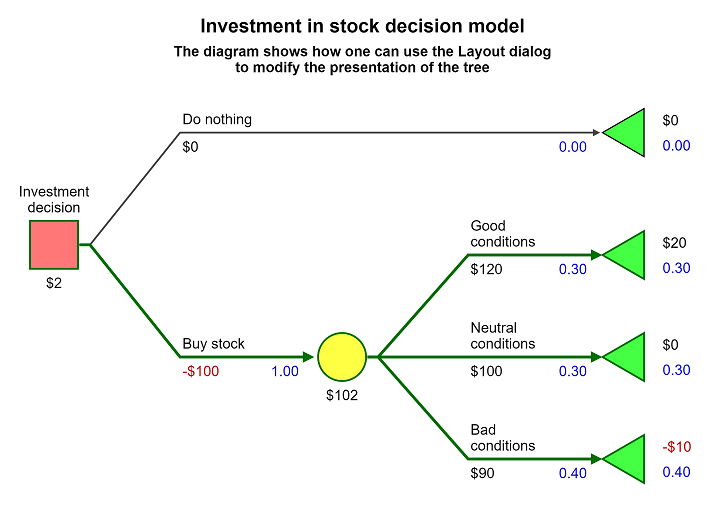
Author: Marcin Czupryna, publishing date: 2016/11/20, open in SilverDecisions
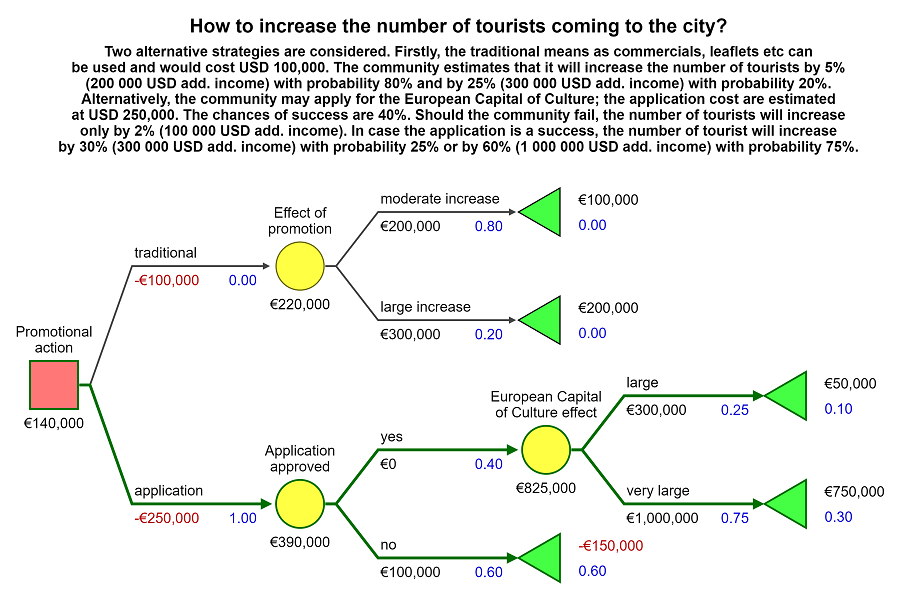
Author: Anna Wiertlewska, publishing date: 2016/11/20, open in SilverDecisions

Author: Anna Wiertlewska, publishing date: 2017/02/10, open in SilverDecisions
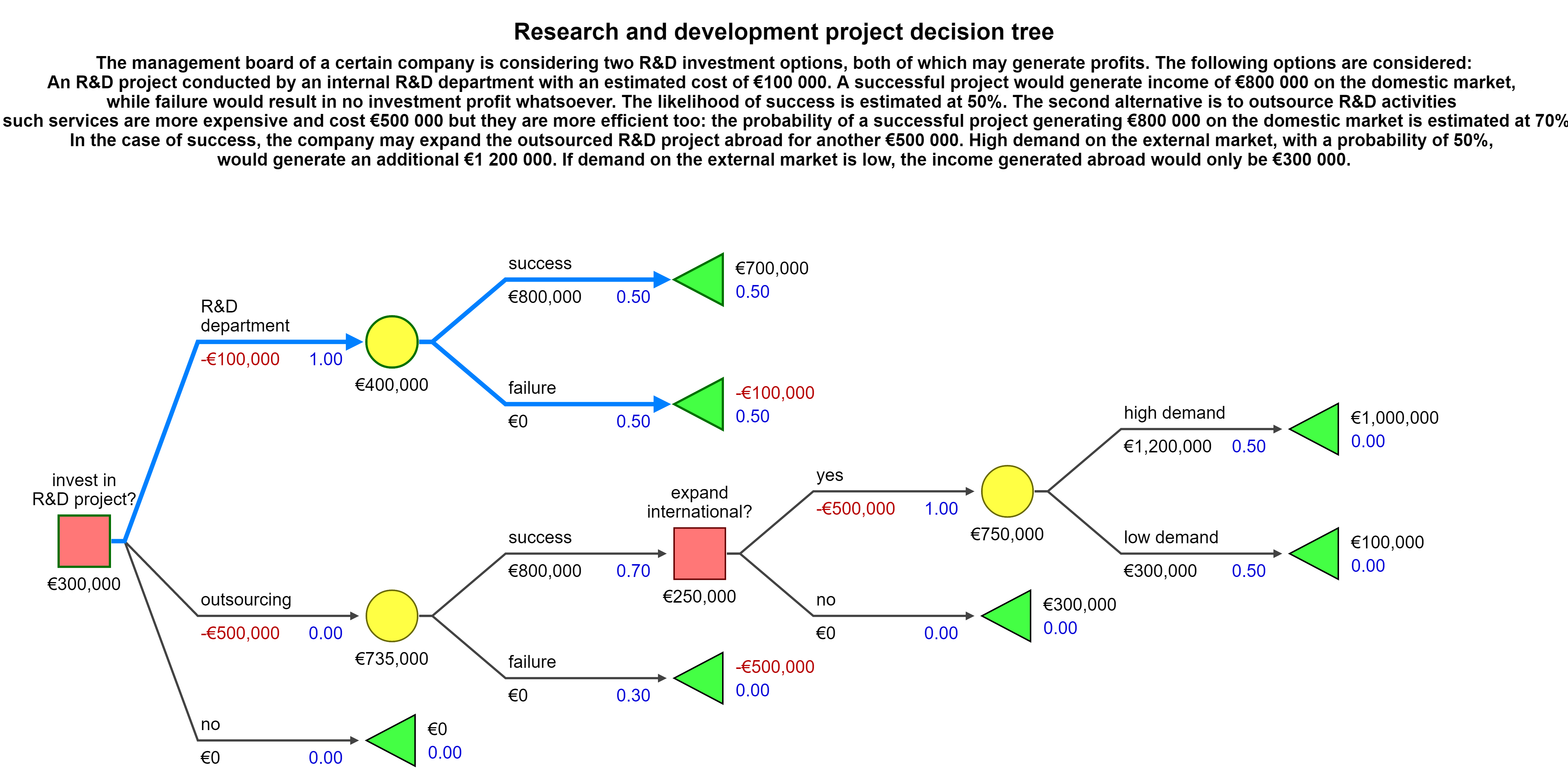
Author: Anna Wiertlewska, publishing date: 2017/03/07, open in SilverDecisions
Decision problem description:
New administration management software is needed: which decision is better - to purchase the software from the solutions available in the market or to outsource the software coding?
City council needs a new software system for effective schedule and employees management – such investment would reduce the management cost by as much as $300 000 within the next 3 years. The software might be chosen from the ones already available in the market – purchase cost is $120 000. City council estimates that such software would fulfill its needs with probability 70%. Unfortunately, there is still the chance that the system purchased in the market would not fit the city council’s needs and consequently would turn out to be useless (the chance is 30%). On the other hand, the city council may outsource the external company to code the software for $80 000. Such software for sure will fulfill Public Administration’s needs, but there is the risk estimated at 50% that it would not work properly.

Author: Anna Wiertlewska,
publishing date: 2017/03/07,
open in SilverDecisions
based on talks with ROUTE-TO-PA Public Administration Pilots
Decision problem description:
The population of a certain Dutch town declines and consequently the healthcare services, education quality as well as living conditions little by little get worse there. What’s more there are no optical fiber cables available as the providers are not willing to invest in that region. Fast Internet is crucial for both: the companies and the people living there. With no fast Internet there might be no new investments in the town at all. And no new companies’ investments means no job for the citizens. Should the Public Administration participate in the Internet infrastructure investment to make the town more attractive for the companies and citizens?
If the city participates in the investment costs, it would have to pay EUR 2.2 M. However, PA estimates that such investments would increase its tax incomes within the next few years by EUR 2 M with the probability 40%, by EUR 1.5 M with the probability 30% and by EUR 0.5 M with the probability 30%. On the other hand, if the investments are not made, the city will incur alternative costs as the result of worse public services and decreasing population: PA estimates that the alternative cost would be EUR 0.8 M with the probability 35% or EUR 1.2 M with probability 65%. PA wants to minimize it’s expected costs.

Author: Kacper Szczurek, publishing date: 2017/03/07, open in SilverDecisions
Decision problem description:
A big European city faces the problem with non-efficient public transport: bus routes and schedules should be optimized, services quality needs improvement and there should be more conveniences for the commuters like modern ticket sales systems or functional mobile applications. The latter could also provide extra benefits for the PA as the result of direct advertisement, gathering data for analysis etc. But firstly, IoT solution needs to be developed by IT programmers as an R&D project which is quite expensive and risky – PA does not know what its outcome would be.
- If PA decides not to launch the R&D project, there are no direct costs incurred however there is the alternative cost of EUR 1 M as the result of traffic jams, wasted time of commuters and consequently citizens’ dissatisfaction.
- If the R&D project is launched, PA needs to pay EUR 5 M for its development. The probability of a successful project is estimated to be at least 60%.
- If it succeeds, PA analyzes its outcome and efficiency to decide whether it’s worth implementing or not as the implementation costs another EUR 1 M.
- Finally, if the IoT solution gets implemented it might be successful by bringing all the expected results or it might be unsuccessful (here means as not all the goals are met). The probability of failure is estimated at 10%. Successful IoT solution implementation may bring EUR 8 M of profit.
There are no additional costs of project failure, unsuccessful implementation or for not implementing the solution - apart from the alternative cost of EUR 1 M mentioned above.

Author: Anna Wiertlewska,
publishing date: 2017/03/07,
open in SilverDecisions
based on talks with ROUTE-TO-PA Public Administration Pilots
Decision problem description:
Local government needs to reduce the greenhouse gases in the region by at least 15% in 2 years time. Naturally, the greater the emissions reductions, the better. The specificity of the region enables considering three alternatives.
Firstly, local government may introduce tax credits and grants for wind power energy. This scenario depends on the investment conditions. Good investment conditions should lead to the greenhouse gases reduction of 20-30% within the next 2 years. The chance of an economic slowdown is merely 10%, but then there will be no new green energy investments in the region and consequently no emissions reduction.
Another alternative is to co-finance the households furnaces replacement. This scenario should decrease the greenhouse gases by 15-30% in case the majority of citizens are willing to participate in furnaces replacement cost. Local government estimates the probability of such situation at 60%. If the majority of citizens is not willing to do so, then emission reductions could be only 10-20%.
Finally, local government may provide free public transport in central zones in line with increasing its standard. This alternative is considered to be 100% success: the overwhelming majority of citizens declares they would switch to public transport if it’s free of charge and in good standard. Such scenario should reduce the gases by 10-20%.
It is estimated that the long-term costs of all three alternatives could be at the similar level. Local government would like to visualize the decision problem with all its alternatives to make it more transparent and understandable before making any decisions.
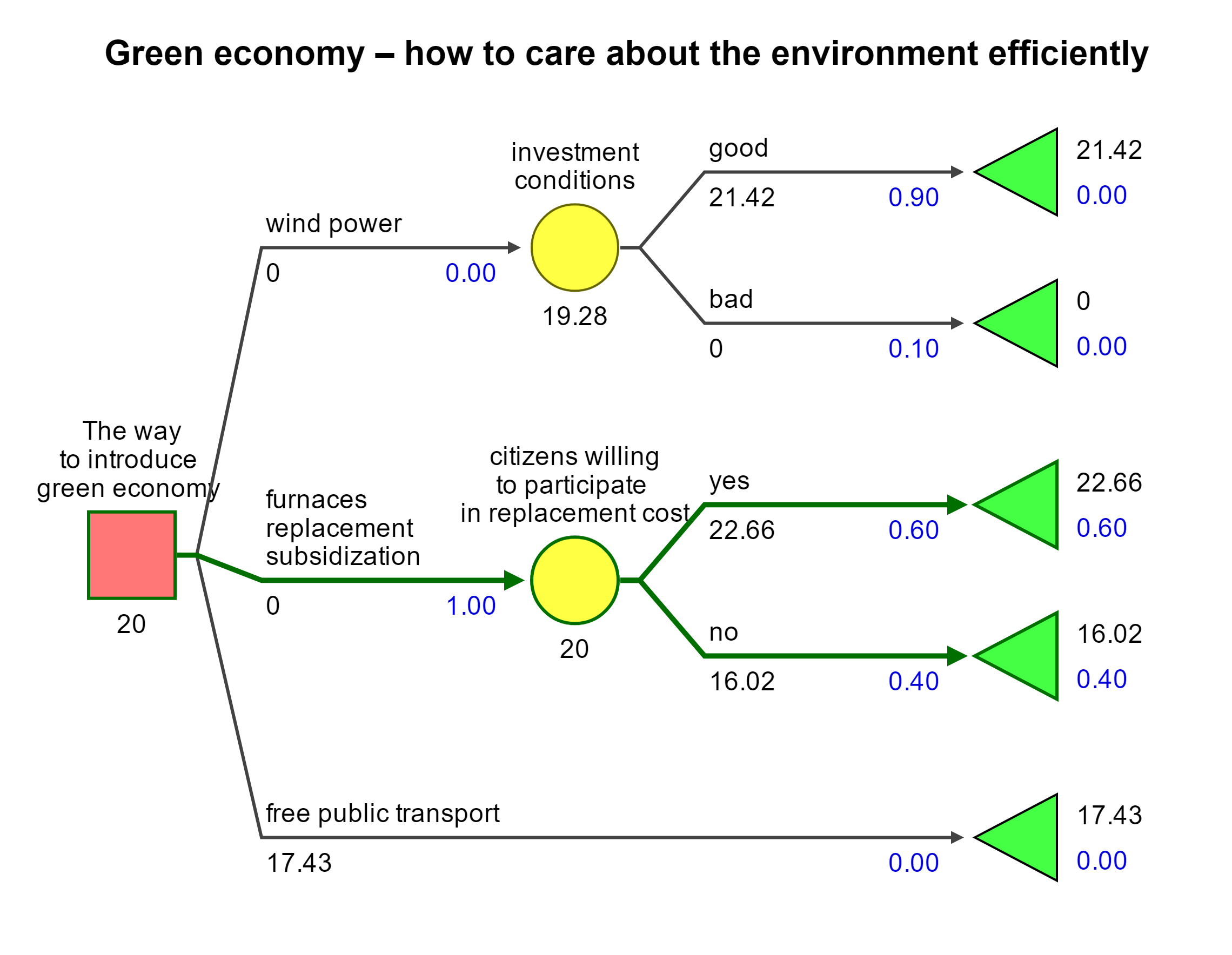
Author: Kacper Szczurek, publishing date: 2017/03/07, open in SilverDecisions
Decision problem description:
Local government considers taking advantage of digital technology and setting up an acceleration center for programmers to overcome societal and economical challenges. In order to maximize the success rate of overcoming challenges two different models are considered, both of them generates similar cost. Last year there was a survey conducted by local government in order to recognize population needs, expectations and their potential actions as the consequence of acceleration center launch. Based on the information received from the survey, local government is allowed to make some estimations.
In the first model programmers accelerator may be found as an independent unit that focuses on challenges and provides trainings to the programmers. According to the survey, this alternative brings the threat of outflow of 80% of programmers after the completion of trainings with the probability of 50%-60%. In case of such outflow the success rate of overcoming challenges will reach only 20%-30%. Otherwise the success rate may be from 70% even up to 90%. Another scenario sets an independent unit and assumes singing contracts with programmers that would block the outflow. This alternative will be less attractive for the programmers and with the probability of 70% their number will be significantly smaller, so their success rate will be only 15%-25%. If their number is not significantly smaller, the success rate may reach 60%-70%.
The second model assumes setting the programmers accelerator in cooperation with established IT companies. This alternative allows blocking the potential outflow, however since the programmers are also focused on day-to-day work, the success rate may only be 50%.

Author: Anna Wiertlewska, publishing date: 2017/03/07, open in SilverDecisions
Decision problem description:
Public Administration plans to set up a Cloud Artificial Intelligence Monitoring System (CAIMS) to increase the comfort, security and quality of citizens’ life. PA aims to maximize systems’ quality to price ratio (QP) thus it considers either organizing a competition for a ready to implement solution or organizing a public tender with a proper set of criteria. Both actions may result in completely different outcomes (relatively higher or lower quality systems with certain probabilities and QP values) which are based on some independent factors like developers’ skills or companies’ efficiency. The problem is that PA first needs to decide whether to organize a competition or a public tender. Right after this decision is made, PA may focus on the offer’s details like cost, specification or timing. It’s worth noting that some alternatives can be way more expensive than others but then the quality of CAIMS might be much better. Each alternative may result in success (relatively higher quality solution) or failure (relatively lower quality solution) – but this quality differs between scenarios: the best way to compare it is to measure QP ratios.
When it comes to the competition, two scenarios are considered. In the first one the price of EUR 1 M will result in a higher quality solution with a probability of 30% and 6 QP. Otherwise it’s 0.5 QP. The second competition scenario assumes the price of EUR 10 M which will result in a higher quality solution with a probability of 60% and 8 QP. Otherwise it’s 1.5 QP.
In case of public tender there are two criteria PA focuses on: the price and the economically most advantageous tender (EMAT). In case of criteria ratio for the price and EMAT 3:1 the chance of development of a higher quality CAIMS is 40% and results in 10 QP, however the chance of development of a lower quality system is 60% and it results in 1.5 QP. In case of criteria ratio 1:1 the chance of development of a higher quality CAIMS is 50% and results in 2 QP. Otherwise it is 1 QP. Finally setting the criteria ratio at 1:2 may result in higher quality system with the probability of 80%, however due to the higher price the QP is 3. Otherwise it is 0.1 QP.

Author: Kacper Szczurek, publishing date: 2017/03/07, open in SilverDecisions
Decision problem description:
Public administration wants to raise awareness of importance of vaccinations. As the campaign will be subsidized by the government (30%) and pharmaceutical industry (70%), PA focuses rather on the immunization awareness ratio increase than on the cost, when considering different alternatives (the amount of the subsidy depends on its potential outcome).
PA may apply for a high subsidy to start an expensive social campaign that would reach a target group and consequently would raise their immunization awareness by about 30-35pp. Alternatively, PA may combine a cheaper social campaign with the slight change of educational programme. This scenario is a bit more complicated and time-consuming but can be more efficient too. The probability of reaching the target group here is estimated at 80%: if target group is reached, campaign is successful and the ratio should increase by about 20-40pp. Otherwise, the increase would be maximum 10pp. In such case, PA may additionally ask Non-Government Organizations for help, as they have been quite popular recently thus they could drive the ratio a little bit up. The problem is that PA does not know if NGO would be willing to help - the chances are estimated at 50:50. If NGO decide to help with the campaign, the ratio should increase by 30-40pp.

Author: Anna Wiertlewska, publishing date: 2017/03/07, open in SilverDecisions
Decision problem description:
Public administration in a certain region wonders whether it should support young people with English training programme subsidy. The lack of subsidy significantly decreases the chances of students knowing English what may result in increasing unemployment rate among youngsters in this region by even 20pp. This in turn would result in the need of subsidizing jobs in the amount of PLN 4 M or in the need of setting an extra fund for unemployed students in the amount of PLN 6 M. The chance that any of these situations would occur is estimated for 40% for each. There is also the risk that both situations may happen what would generate a total cost of PLN 12 M. On the other hand, a comprehensive English course for students is expensive and PA would have to pay PLN 5 M for it. What is more, in case of the subsidy, the unemployment rate will probably considerably decrease (so no above unemployment expenses would be needed anymore) but there is the risk that a significant number of students may emigrate what would diminish a public budget by another 3 M.
PA would like to visualize this problem to see its possible decisions consequences.

Author: Anna Wiertlewska, publishing date: 2017/03/07, open in SilverDecisions
Decision problem description:
Public Administration would like to increase the number of tourists coming to the city. There are two marketing options available: traditional marketing (here means as basic TV commercials and billboard advertising) which costs EUR 10 000 and digital marketing (online marketing such as banners, VOD, text marketing etc.) which costs EUR 13 000. PA may also consider mixed marketing which is the combination of those two and costs EUR 16 000.
According to the latest research and touristic market trends (the number of tourists in this region increases every year by about 5%) there might be two overall marketing campaign results: moderate increase with 5%-15% more tourists compared to the previous year or high increase with 10%-30% more tourists in comparison to the previous year. 100% increase in the number of tourists would bring as much as EUR 100 000 additional income to the budget. PA marketing department estimates, that generally traditional marketing results in high increase with probability 25%, digital marketing with probability 55% and mixed marketing – 75%. Mixed strategy is the most efficient way of marketing but it is the most expensive option too. And PA does not know the exact increase of the number of tourists: it is probably a value between 5% and 15% (moderate increase) or 10% and 30% (high increase). So the question is how to promote tourism in the city in the most efficient way?

Author: Kacper Szczurek, publishing date: 2017/03/07, open in SilverDecisions
Decision problem description:
There are several ways Public Administration may support innovation of enterprises. Each of them has different costs and may result in different efficiency of innovations implementation.
Firstly, PA may simply introduce tax relief for R&D which would cost EUR 0.5 bn as the result of lower CIT income. But the PA expects that the innovations will increase by 20% with the probability of 70%. Secondly, PA may directly support innovative companies through grants and credits for R&D and innovation projects, what would cost EUR 1 bn and here it can expect the increase of innovation by 25% with the probability of 80%. Finally, grants may be obtained by the companies indirectly through vehicles specialized in investing in innovative projects. The public administration may co-fund their investments which would cost EUR 0,75 bn and may result in the raise of innovation implementation by 30% with the probability of 75%.
As long as the probabilities and innovation changes are feasible to estimate, the exact money result of PA actions is quite difficult to assess. PA estimates, that in the first scenario 20% of innovation increase could generate about EUR 1 - 1.5 bn. In the second scenario, 25% of innovation increase may generate about EUR 1-2 bn. Finally, the last alternative is quite tempting but risky too – it may generate 0.5–2.5 of profit.
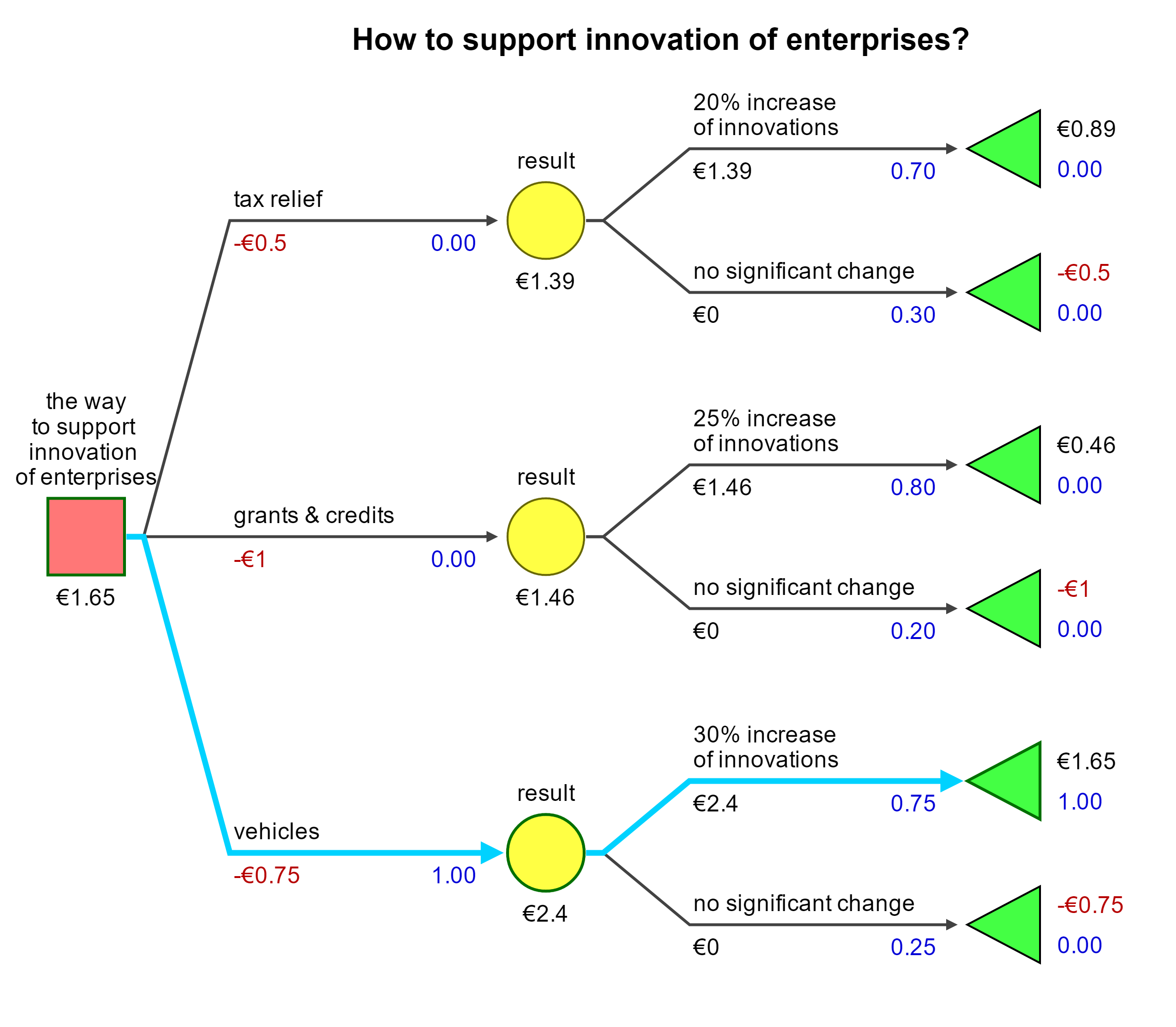
Author: Anna Wiertlewska, publishing date: 2017/03/07, open in SilverDecisions
Decision problem description:
The city considers allowing citizens to build houses on floodplains areas. This may bring new profits and provide ground for housing in the crowded city, however increases risk of natural disaster. If the city decides to allow the citizens to build their houses on floodplain areas the city will gain extra USD 5 M from the sale of land. However it will also be related to a need of improving the anti-flood system which may costs USD 4 M with probability of 40% or USD 6 M with probability 60% depending on the future examination. In case the city does not provide the extra land the city will decrease its population which results from overcrowding by 5% with the probability of 25%, by 8% with probability of 40% and by 10% with the probability of 35%. This will decrease the incomes of the public budget by EUR 1, 3, 5 M respectively
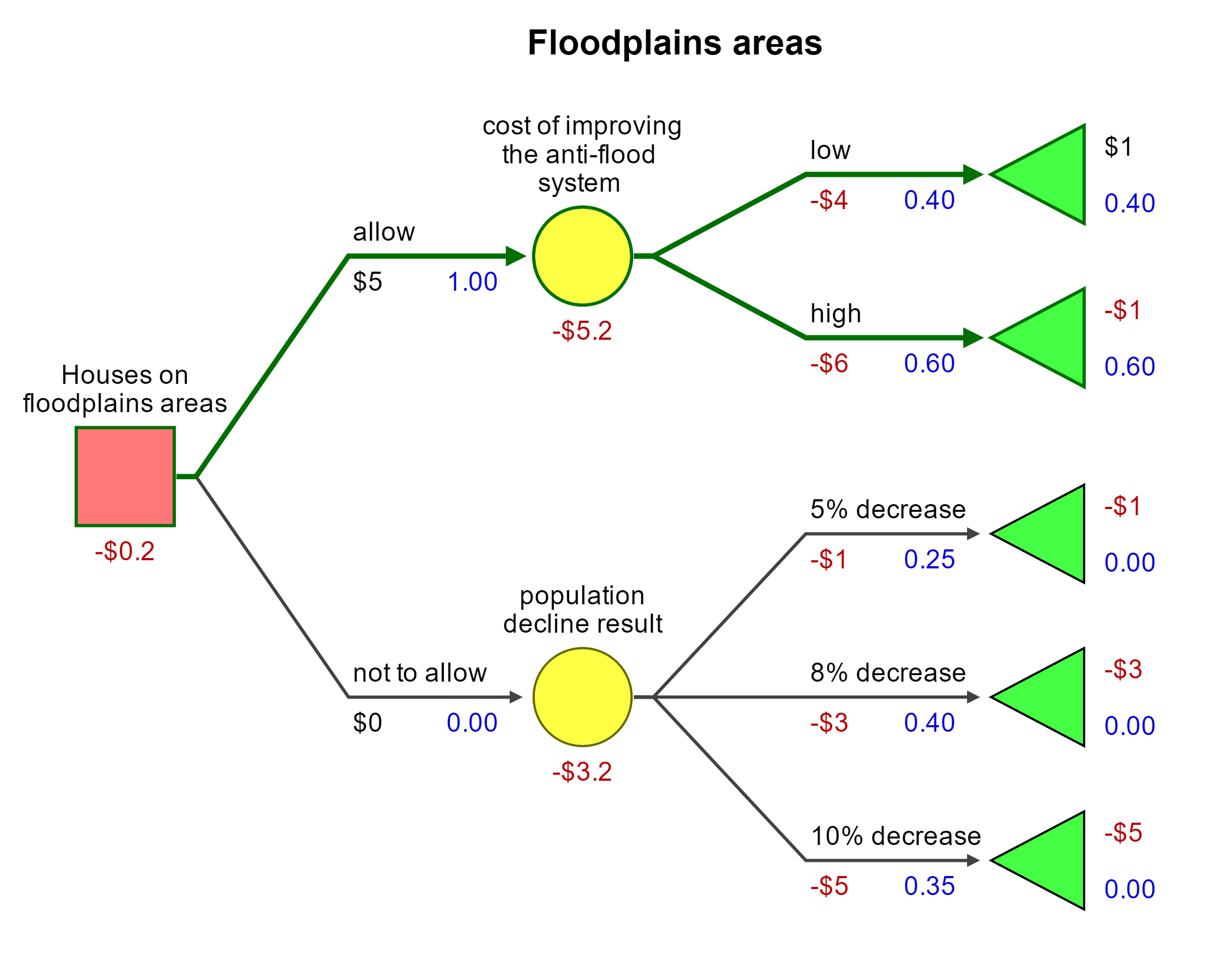
The project is developed at Decision Support and Analysis Division, Warsaw School of Economics
as a part of ROUTE-TO-PA Project that has received funding from the European Union’s Horizon 2020
research and innovation programme under grant agreement No 645860.

